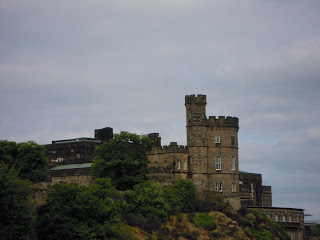
 I would say it was our first day in Edinburgh, but as the sun never truly set and I didn't exactly sleep besides an hour-long nap in an armchair, I can't exactly say that this felt like a new day... Nevertheless we set out in an all new city. Edinburgh has a totally different vibe than London, and while the locals may be speaking English, the Scottish accent can be so thick that it is near impossible to understand. This contributes to the feeling that one is really in a foreign country and exposed to a very different culture in a way that being in England does not.
I would say it was our first day in Edinburgh, but as the sun never truly set and I didn't exactly sleep besides an hour-long nap in an armchair, I can't exactly say that this felt like a new day... Nevertheless we set out in an all new city. Edinburgh has a totally different vibe than London, and while the locals may be speaking English, the Scottish accent can be so thick that it is near impossible to understand. This contributes to the feeling that one is really in a foreign country and exposed to a very different culture in a way that being in England does not.We started out stopping by the National Library of Scotland as a group, although we did not have a tour scheduled here. We had a chance to check out their special exhibits that are currently running which included a case of Pride and Prejudice memorabilia featuring a first edition from 1813, and a larger multimedia display of Livingstone's journeys and expeditions through Africa complete with a to-scale map comparing Scotland to the African continent. A reader card is required to access the main library so I couldn't explore that.
After a few hours to experience the city and grab some (very excellent) lunch at the Guildford Arms, we met up at the statue of the Duke of Wellington (who had quite a few feathered friends) outside of the General Register House on Princes Street. This was formerly the National Archives of Scotland, but as the result of a merger with the General Register Office for Scotland in 2011 it is now part of National Records of Scotland. This structure was conceived in the 18th century as the Scots were concerned about the welfare of records then residing in Edinburgh Castle, Scottish parliament and other locations. Though moving the records was proposed about 50 years before, construction of the purpose-built repository did not begin until 1774, to the designs of architect Robert Adam. Upon entering the General Register House, you proceed through a set of doors into the Roman Pantheon inspired Adam Dome which was completed in the 1780's. The 'New' Register House is behind the General Register House and along with the Thomas Thomson House which is in West Edinburgh and not open to the public, these three structures house the National Records of Scotland.
 |
| Photo Credit: NRS |
The end of our visit provided to time to handle a few original documents and also some facsimiles of materials that Margaret, the head of Educational Services handpicked for us (photographs were not allowed, however). There was a selection relating to each of the states our schools reside in (mine was correspondence to Pennsylvania), and also a few other special records; two of my favorites were instructions for the envoys between James IV and King Louis XII during England's war with France in 1512 (one page bearing Louis XII's signature!!!) and also facsimiles of prison records which included very early photographs, and they photographed the prisoners not because of expected record-keeping practices, but meant for possible use in identifying the 'look' of criminals. We exited back through the Adam Dome and bid farewell to the statue of King George III which has resided there since 1795.
After our appointment it was time to do some epic souvenir shopping. We walked over the North Bridge and then up the Royal Mile, and it was almost a challenge to try and go in every shop hawking anything plaid, woolen, Scottie dog or highland cow related.





No comments:
Post a Comment